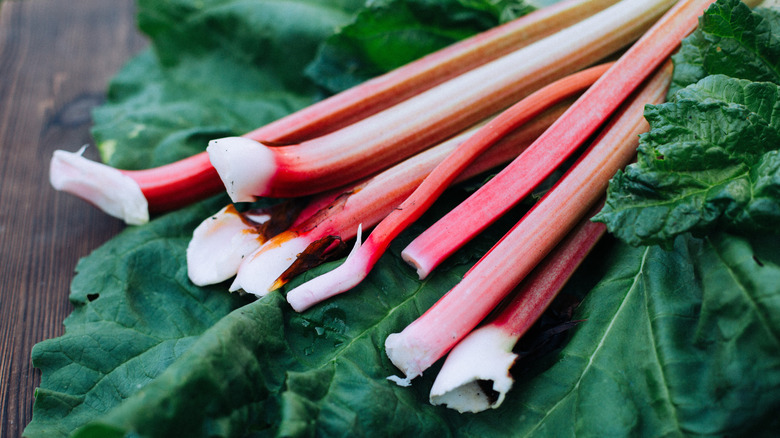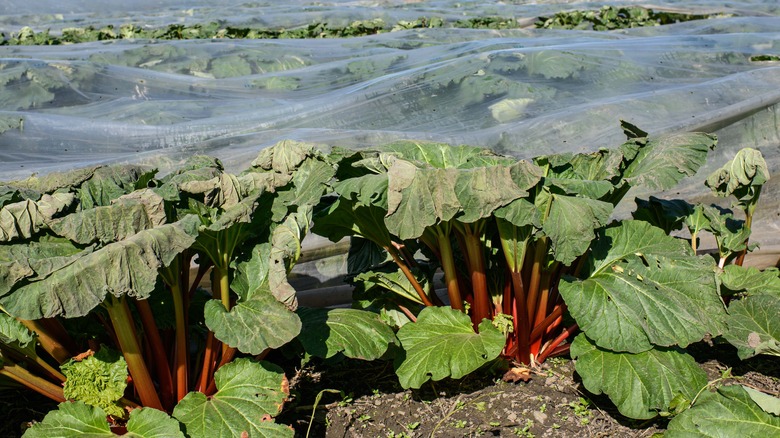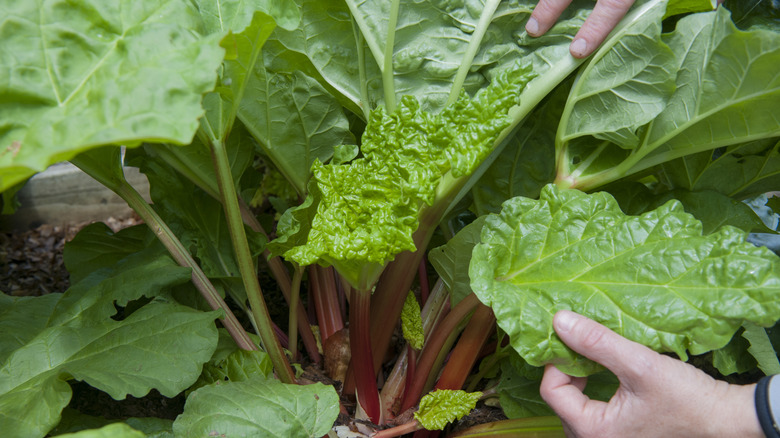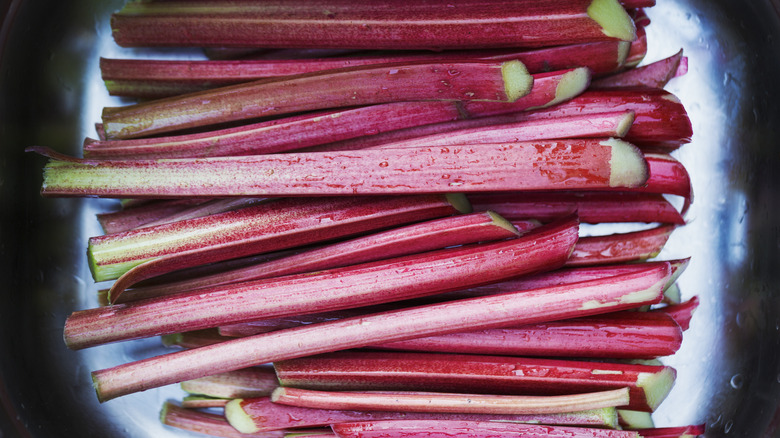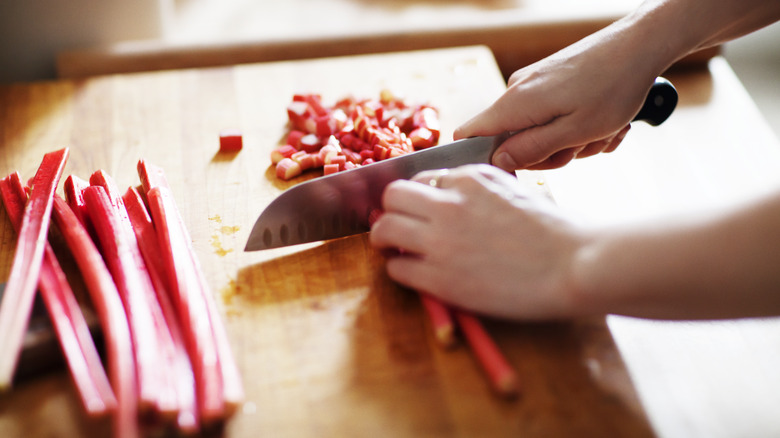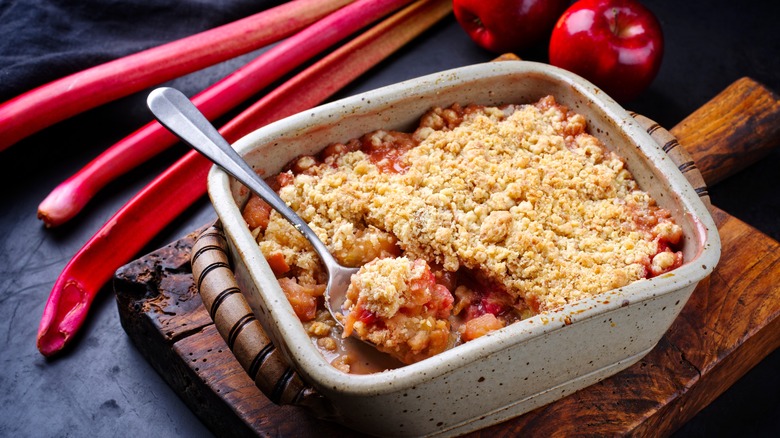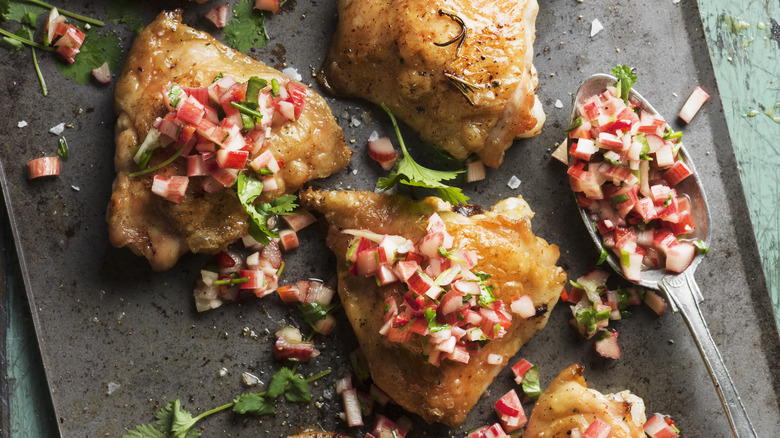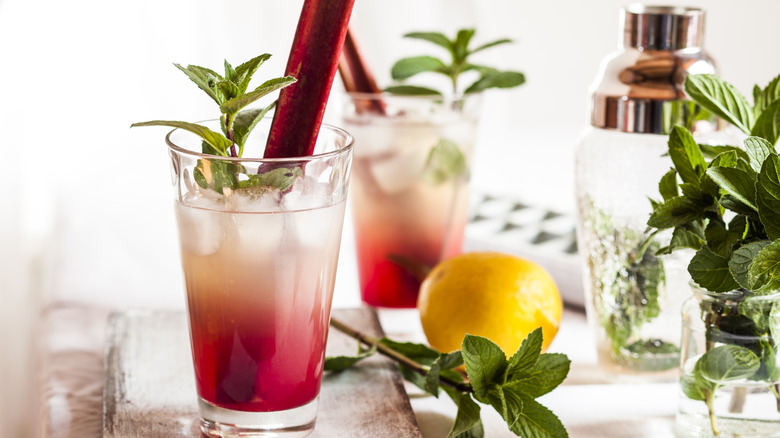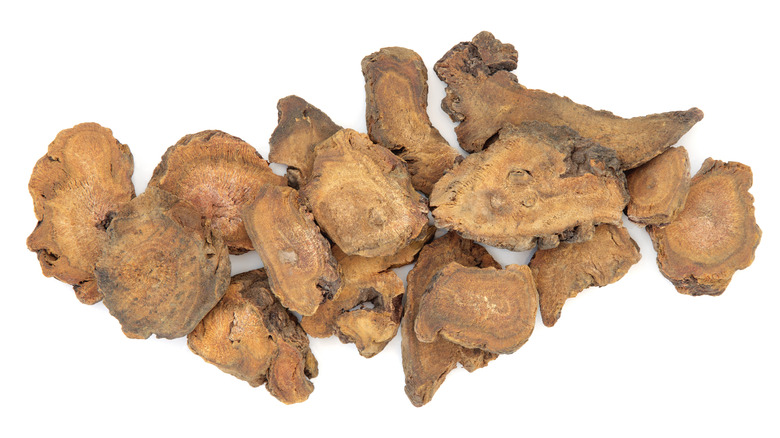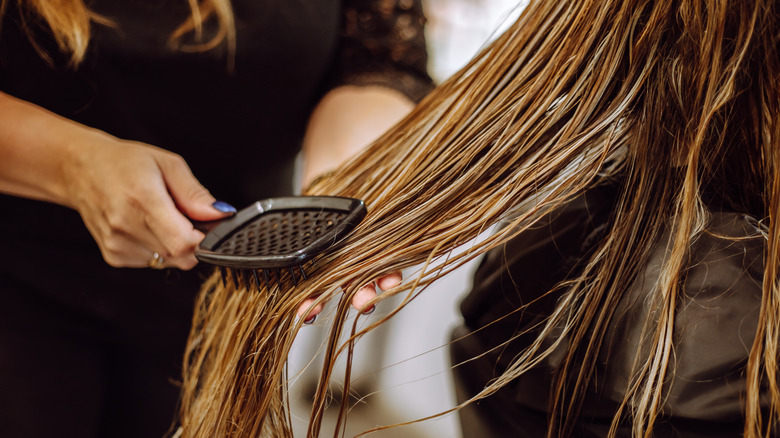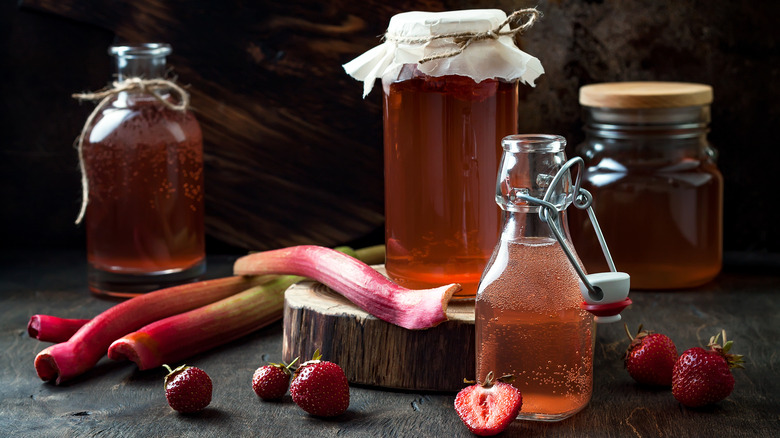What Is Rhubarb And How Do You Cook With It?
We may receive a commission on purchases made from links.
Rhubarb is a unique ingredient you may see pop up on menus or in the aisles of your local grocery store. Come springtime, depending on where you live, you might even stumble upon some fresh rhubarb at your local farmer's market, which may tempt you to grab a bunch and see what you can do with it. But in all your excitement, you may yet be wondering: What exactly is rhubarb? It's a vegetable, but it's usually sweetened, operating in tandem with a fruit. It looks a lot like celery, but it tastes more like a lemon. So, what's going on here?
These bright red, pink, or green leafy stalks can be a little tricky to work with, but we're here to demystify the stalky seasonal vegetable and encourage you to try some if you haven't already. With a flavor often referred to as tart or tangy, rhubarb pairs well with fruits and can help cut the sweetness of desserts and sugary beverages. Most often guest starring in baked goods, jams, and fruity summer cocktails, rhubarb is a surprisingly versatile vegetable that has its place in the world of savory dishes as well. It's definitely worth investigating, and we've broken down the basics to get you started.
What is rhubarb, exactly?
Rhubarb is a hardy perennial plant that grows in cooler climates. In North America, that means the northern U.S. and Canada. There's even a variety called Canada Red. You likely won't see much rhubarb in the southern United States as it doesn't fare well in the heat and requires colder temperatures (below 40 degrees Fahreheit) to start growing each year. A member of the buckwheat family (Polygonaceae), it is a relative of garden sorrel. Not all rhubarb plants are edible, but the edible ones are called Rheum rhabarbarum.
Rhubarb originated in Siberia, and today it grows around the world, typically in the spring and summer months. Used for medicinal purposes for centuries, people began eating rhubarb in the 1700s. There are several unique varietals of edible rhubarb – including the Crimson Cherry and Victoria varieties, which grow up to four feet tall, and the Holstein Blood and Glaskins Perpetual varieties with their deep red stalks — all of which are commonly used for baking. Other varieties are more green in appearance. Frambozen Rood and German Wine varieties are commonly used in beverages. Some rhubarb grows wild, and some is cultivated in fields or in greenhouses.
Don't eat rhubarb leaves
Unlike the other leafy greens on offer at the market, rhubarb leaves are not for eating. You won't want to sautee or stew the leaves of the rhubarb plant like you would Swiss or rainbow chard, kale, or collard greens. In fact, rhubarb leaves are not safe for consumption at all.
The cramp- and nausea-inducing leaves contain dangerous levels of oxalic acid, which can even be fatal when consumed in high enough quantities. People probably learned this the hard way when they began eating rhubarb centuries ago, but they quickly discovered that only the stalks were safe for consumption. Some people even believed it was not safe to harvest rhubarb stalks later in the summer, as the oxalic acid levels in the leaves would rise throughout the growing season. The stalks themselves actually remain safe to eat, but they do still recommend avoiding harvesting any rhubarb after a big freeze. It's possible severe temperatures will cause the oxalic acid crystals to move into the stems of the plant. However, rhubarb can be grown in winter to increase overall annual yield. This "forced" rhubarb is grown indoors in greenhouses and therefore not affected by frost.
Enjoy edible rhubarb stems
The stem of the rhubarb plant is the main attraction when it comes to cooking. Tall, crisp, and tart, they can be enjoyed in a variety of sweet and savory dishes. Cleaning and preparing rhubarb stems shouldn't be too complicated. Somewhat resembling celery, these tough, sour stalks aren't always very nice to eat raw. However, when cooked (and typically seasoned with sugar), they become a deliciously tart addition to many foods and beverages. And, in fact, there are some slightly sweeter varieties of rhubarb that can be eaten raw.
It's safe to eat green rhubarb. The color of the stalk isn't necessarily an indicator of whether it's ripe enough to cook with or even how sweet it will be. Some rhubarb varieties are naturally more red, while others are pink, spotted, or even green when fully ripe and ready to consume. And the sweeter varieties aren't always the redder ones.
Preparing rhubarb for consumption
Preparing rhubarb can be easy — just make sure to remove the leaves and wash off any dirt. You can also likely pick up some from the store that is already trimmed and ready. That said, rhubarb is definitely one of the hidden gems at the farmer's market if you're in the right climate.
British celebrity chef Jamie Oliver shared some quick and easy tips for preparing rhubarb, and his method is just a few notches up from the simplest standard preparation. He recommends slicing the stalks into centimeter-thick pieces and cooking them down with sugar, ginger, and thyme for added aromatics. After a few minutes you can separate the softened rhubarb pieces from their juices (a kind of cordial which you can mix into drinks and sauces) or continue to cook it all down into a compote. The resulting rhubarb can be kept in the fridge and used to make all kinds of drinks and dishes. You can also roast chopped rhubarb rather than cooking it on the stovetop.
Making dessert with canned ingredients can work just as well or better than fresh depending on the recipe, and canned rhubarb is a great shortcut when you don't have access to fresh rhubarb or time to prep it. It's also a good option when craving rhubarb flavors out of season. You might find canned rhubarb in the baking or canned vegetable aisles, or you can buy canned rhubarb online for ultimate convenience. Just keep an eye on the sugar content of your canned rhubarb and adjust your recipe accordingly.
Baking with rhubarb
Strawberry rhubarb pie is probably the first dish that comes to mind when you think of rhubarb. These two fresh and brightly-colored ingredients tend to grow in season together, and that's likely how they got teamed up in this classic early summer dessert. It's a common household favorite, especially in the U.K. and Canada. It's definitely worth baking a strawberry rhubarb pie if you haven't already, and there are plenty of other strawberry rhubarb bakes like crumbles, bars, or cakes.
But you don't have to pair rhubarb with only strawberries. When cooked with enough sugar, rhubarb can stand on its own as a featured flavor. Give this easy rhubarb cake a try if you're rhubarb curious. Apple and custard are other classic rhubarb companions — you could serve an apple rhubarb crumble with warm custard, or bake some rhubarb and custard bars for your next potluck. You can also pair rhubarb with tasty warming spices like ginger that compliment its tangy flavor. Rhubarb and cardamom oat muffins are a perfect breakfast treat.
Keep in mind that fresh rhubarb can release a fair amount of liquid when cooking down, so you may want to remove some of the syrup and juices before baking it into certain dishes. It won't be a big problem in a crisp or crumble, but cakes and pies can get soggy with too much liquid involved.
Cooking with rhubarb
There's more culinary use for rhubarb beyond just baking. You can keep cooking it down into a nice jam, for one thing. Rhubarb, strawberry rhubarb, and rhubarb and ginger all make great jams. Spread some on toast or put a little on the side of a cheese or charcuterie board. As mentioned, you can also make sauces and syrups. Those can be used for desserts, added to dressings for some bright and tangy sweetness to your salads or drizzled over other savory dishes. A rhubarb salsa or chutney might be even better with meat. The flavor pairs well with chicken and pork as well as other roasted vegetables.
Raw rhubarb can even provide a little tart crunch to fresh dishes. Taste your rhubarb first, though, as some varieties of the plant are sweeter and less bitter or sour than others. If the flavor is nice and the texture is easy to chew, you can toss some thin slices of fresh rhubarb right into a salad — it's a colorful alternative to shaved fennel for those who don't love anise flavor — or even add rhubarb into a potato salad the way you might use chopped celery to add some color and texture. Of course, rhubarb's flavor will be stronger than celery, so don't go crazy.
Drinking with rhubarb
Rhubarb flavor is as lovely in the bar department as it is in the kitchen. It's actually one of the ingredients in the complex flavor profile of Aperol and Campari. If you're a bit of a mixologist, you can also find rhubarb bitters as a unique addition to your bar. Rhubarb's acidity can add brightness and pucker to a drink. Brightly colored and tart, rhubarb pops up in refreshing spring and summer cocktails, often paired with gin or vodka. Make a rhubarb gin and tonic or a rhubarb vodka soda by adding a little rhubarb syrup, cordial, or rhubarb pureé to the drink. Or even top some rhubarb cordial with Prosecco and soda water for a less boozy, fresh, and tangy spritz.
Rhubarb sodas also pop up on the market in many locations. These are a great non-alcoholic option, especially for those who don't like super sugary flavors. If you like the sound of that but can't find any at a grocery store near you, you can make your own rhubarb soda by adding soda water to a rhubarb syrup or cordial. And if you can't find those either, it only takes a click or two to order some rhubarb pureé or strawberry rhubarb mix online.
If you have a juicer, you can try juicing fresh rhubarb stems. The juice will be more sour than sweet, but can be a nice addition to other fruit juices. Rhubarb wine is a thing too, though it's not commonly available at your average liquor store.
Health and nutrition of rhubarb
As mentioned earlier, rhubarb was traditionally used for medicinal purposes, including the treatment of fever and stomach aches. The ancient Chinese were using rhubarb as a medicinal plant as far back as 5,000 years ago, and it's still used to treat constipation to this day. There is some research that shows the anthocyanin and lycopene present in rhubarb could also have the beneficial health properties of maintaining healthy blood pressure, kidney health, and preventing cancer. The high levels of vitamin K could also support bone health. And rhubarb is sometimes used to treat renal failure, diabetic nephropathy, and pancreatitis.
However, it is probably best to consume rhubarb as a food and not as a supplement. Concentrated rhubarb in this form can have potentially dangerous effects. We've already discussed the presence of oxalic acid in the leaves and roots of the rhubarb plant, which is toxic for human consumption. It also contains calcium-oxalate, which can contribute to the formation of kidney stones. Although there is a considerable amount of calcium present in rhubarb, this form is not easily absorbed by the human body, so rhubarb should not necessarily be considered a great source of calcium. It is, however, a good source of manganese, vitamins C and K, as well as antioxidants and fiber.
But look out! Rhubarb is on the list of foods that can do weird things to your body. Like beets, rhubarb has the potential to turn urine red. If you've eaten some, keep that in mind before calling your doctor the next morning.
Other uses for rhubarb
Rhubarb, with its bright stalks, heart shaped leaves, and flowers, is often planted for aesthetic purposes. It can be a beautiful addition to a garden or even a floral arrangement. Some species of rhubarb are considered purely ornamental and aren't consumed as food.
Aside from its deployment in traditional herbal medicine, there are also some cosmetic uses for rhubarb. The root of the plant is used in herbal hair treatments and is purported to have a dyeing/lightening effect that also boosts shine and strips other product buildup. Some companies sell rhubarb powders, masks, shampoos, and other treatments. You can make your own rhubarb hair treatment by simmering some fresh or dried rhubarb root in water, letting it steep, and washing your hair with it. Just be sure to cover the pot while it simmers so you don't breathe in the oxalic acid in the steam.
Rhubarb has also been used to clean metal, tan leather, and as a natural form of pest control. The very same oxalic acid which makes its roots and leaves inedible can be helpful for these purposes.
Storing rhubarb at home
So you've gone to the trouble of buying some rhubarb and you've cooked it down with sugar and spice and everything nice. Now what? If your recipe only calls for a little, or you don't have a specific use in mind yet, fear not. Prepared rhubarb will last for several days or even weeks (due to the added sugar content) in a sealed jar in the fridge. Certainly a rhubarb jam will last a while.
Sliced fresh rhubarb can also be stored in an airtight container or tightly wrapped in plastic in the fridge for several days. And chopped frozen rhubarb can last up to a year in the freezer. When it comes to the stuff in a can, treat it like any other canned good by storing it in a cool dark place and consuming before the expiration date.
